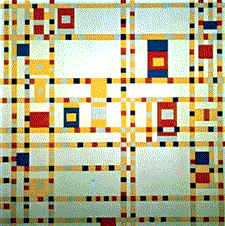Shape and Form
|
Shape and form help organize an artwork. Shapes are two-dimensional surfaces such as circles or squares. Forms are three-dimensional, like spheres or cubes. A concave form has a pushed-in surface that goes down like the inside of a crater or bowl. A convex form has a raised surface that goes up like a mound or the outside of a bowl. Forms can be solid like a rock or have voids like a hollow tube. A void is an empty space.
|

by Piet Mondrian
|
Your eyes and mind work together when you see shapes and forms. You always see them as a figure-ground relationship. The shape you see first is called a figure, or positive shape. The area around it is called the ground, or negative shape. Artists often plan their work so that people must shift their eyes back and forth between positive and negative shapes. When positive shapes are incomplete or unclear, you still see them as a unit without even realizing you are doing it. |
| Shapes and forms are also described in other ways. Organic shapes look like the natural curves in trees, clouds, people and the like. Geometric shapes and forms are usually precise and regular. Shapes look like flat circles, triangles or squares. Forms are like three-dimensional spheres, cones, pyramids or cubes. Artists often use geometric forms to suggest things and places created by people. A free-form is an invented shape or form. It often has qualities of a geometric form or an organic form or both. |
